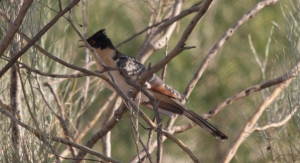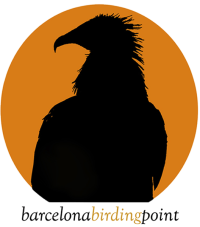Lleida Steppes one-day Itinerary (April 2012)

Bruce mailed me on early-March. He was coming from New York to spend some days with his family in Barcelona and, as any birder in any trip, he wanted to explore the wild around the city he was about to visit. He chose our 1-day Lleida Steppes itinerary in order to get as much nice views as possible of new/European birds. I picked him up in his hotel at 6:00 am, expecting to have a really nice birding day. In our way I was explaining him about the countryside and history around Barcelona both were chating about nature, conservation issues in our countries, and way to understand life in both sides of the Ocean.
Our first spot was some kilometers North of Tàrrega. In few minutes we found the first male of Little Bustard (Tetrax tetrax). It was standing up in the middle of a wheat field, a hundred metres from us. We could see how it was singing in the middle of the green and how its neck was moving with the rythm of its sounds, showing the beatiful neck black-and-white pattern. Some minutes later a second male was arriving to this same wheat field. They both stand beside, only few metres from each other. Every ten-twenty seconds one of them was moving towards its opponent. Males are strongly territorial in spring, defending some fields that they prefer to sing from and where they try to attrack females. Every male arriving to those points is just push it out. It is quite usual to see pursuits of three-four males trying to push out any single male that is appearing inside their headquarter.
It was only eight and a half but some raptors were already moving over the mild scenery; Marsh Harrier (Circus aeruginosus), Black Kite (Milvus migrans) and Goshwak (Accipiter gentilis) were all pratolling over the steppes, looking for mice or so. Some metres from the Bustards there were a pair of Stone Curlews (Burhinus oedicnemus) moving in an open field and beside them a Little Owl (Athene noctua) was watching us from a small, old wall.
Over the fields both Calandra (Melaconorypha calandra) and Crested Larks (Galerida cristata) were singing and flying around. There were also a good number of passerines (Subalpine Warbler –Sylvia cantillans, Northern Wheatear –Oenanthe oenanthe-, Winchat –Saxicola rubetra- Southern Grey Shrike –Lanius meridionalis). I guided Bruce to a corner were a pair Great Spotted Cuckoo (Clamator glandarius) is moving year after year. This is a perfect place to locate them as the area supports a big number of Magpies (Pica pica). Great Spotted Cuckoos prefer to put their eggs on the nests of Magpies.
It had been a nice spot!! I decide to change our location as Bruce was quite interested about birds living in cliffs. Few kilometers West there is a lonely and productive limestone cliff, a nice place to locate some interesting species. In our way we found time to see some species living around villages as Tree Sparrow (Passer montanus), Spotless Starling (Sturnus unicolor) and Common Kestrel (Falcon tinnunculus). We arrived to the cliffs. A pair of Blue Rock Thrush (Monticola solitarius) was moving in the area, quite close to our car. Some minutes later was the time of the jewel of these cliffs as a Black Wheatear (Oenanthe leucura) was moving on the top of the cliffs. It was still time to Stonechat (Saxicola torquata) moving in the shrubs around. Back to the plains I lead Bruce until a nice view-point, an incredible place to locate raptors: we invested twenty minutes and we got an amazing raptors list including Lesser Kestrel (Falco naumanni), Montagu’s Harrier (Circus pygargus), Griffon Vulture (Gyps fulvus), Short-toed Eagle (Circaetus gallicus), Black Kite and Booted Eagle (Hieraaetus pennatus) along with nice views of smaller birds such as Cirl Bunting (Emberiza cirlus), Dartford Warbler (Sylvia undata), Black-eared Wheatear (Oenanthe hispanica) and Calandra Lark.

Mid-day was getting close. It was time to move to our next location, a huge wetland in the middle of the plains, a restored paradise after it was drained in the fifties. It was time to lunch and we both enjoyed the Iberian pic-nic that is Barcelona Birding Point offers to its costumer when enjoying a 1-day Itinerary. Taking advantage of the hides, we both had lunch and easily find some birds around this large lagoon. From that first hyde we located Little Grebe (Tachybaptus ruficollis), Great Reed Warbler (Acrocephalus arundinaceus), Shoveler (Anas clypeata) and Cetti’s Warbler (Cettia cetti) aling with Marsh Harrier and Great Crested Grebe (Podiceps cristatus).
Once we end our splendid food it was time to explore some marshes around the lagoon. The flooded open redbeeds were really productive as they allowed us to locate a good number of waders on passage; the smart and delicate Black-winged Stilt (Himantopus himantopus), Redshank (Tringa totanus), Wood Sandpiper (Tringa glareola), Greenshank (Tringa nebularia), Ruuf (Philomachus pugnax), Ringed Plover (Charadrius hiaticula), Common Sandpiper (Actitis hypoleucos), Green Sandpiper (Tringa ochropus) and Common Snipe (Gallinago gallinago) along with passerines such as Iberian Yellow Wagtail (Motacilla flava iberiae) and Water Pipit (Anthus spinolleta).
But the most interesting was still to come. Thirty meters South from «waderworld» the reedbed becomes dense and impossible to explore. I stopped there looking for something special. At March and early April Little Crakes (Porzana parva) move North to their nesting sites in Central Europe…

We waited for five, ten minutes.. and was appearing. First we listenned its song. A Little Crake was singing in the middle of the reedbed. Astonishing as these birds use to sing at dusk and never use to sing at two o’clock!! Five, ten minutes more searching inside the reeds and finally the Crake was getting out. We both enjoyed a beatiful, long view of the bird, moving along the edge of the dense vegetation.
About two and a half was time to change our location. A second hide was allowing us to discover waterfowls such as White Stork (Ciconia ciconia), Grey Heron (Ardea cinerea), Little Egret (Egretta garzetta), Purple Heron (Ardea purpurea), Whiskered Tern (Chlidonias hybridus), Great Cormorant (Phalacrocorax carbo), Black-headed Gull (Larus ridibundus), Yellow-legged Gull (Larus cachinnans) and Greylag Goose (Anser anser).
The birch forest and reedbeds around the lagoon was also quite productive. Nightingales (Luscinia megarhynchos) and Blackcaps (Sylvia atricapilla) were singing at every corner and we got nice views of Great Reed Warbler (Acrocephalus arundinaceus), Penduline Tit (Remiz pendulinus) and Willow Warbler (Phylloscopus trochilus).
It was time to come back to Barcelona. We arrived to the city about six o’clock. Bruce was really happy as we had got about 80 species of birds in less far less than a day. The weather was also perfect as we enjoyed a sunny day and about 20-22ºc.
I left him in his hotel. You never know, maybe next time we’ll meet in New York.

